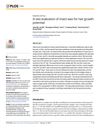Genome Assembly and Methylome Analysis of the White Wax Scale Insect Provides Insight Into Sexual Differentiation of Metamorphosis in Hexapods
November 2020
TLDR The white wax scale insect's genome shows that complete metamorphosis evolved earlier than thought and highlights differences in male and female development.
The study on the white wax scale insect (WWS) provided insights into sexual differentiation and metamorphosis in hexapods by assembling and analyzing the WWS genome. The research revealed that holometabola evolved from hemimetabolous insects about 50 million years earlier than previously thought. The WWS showed high methylation levels (4.42%) compared to other insects, with differential methylation patterns in genes related to steroid and sesquiterpenoid production, as well as fatty acid metabolism. These findings were consistent with the distinct developmental fates of males and females, who produce different profiles of ecdysone and juvenile hormone. The study offered a comprehensive genomic and epigenomic resource for understanding the evolution of metamorphosis and sexual dimorphism in insects.

